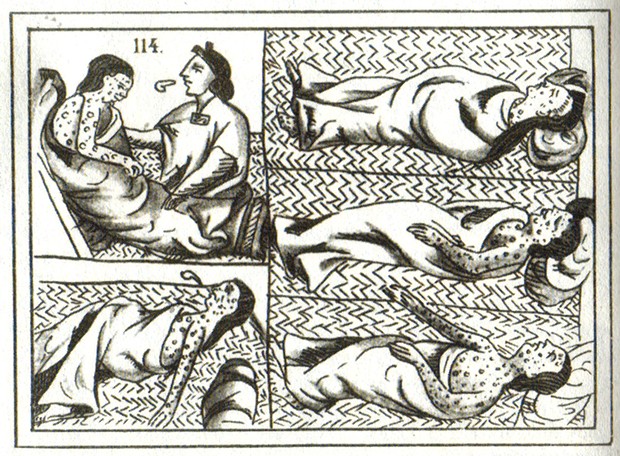[
{
"name": "Top Stories Video Pair",
"insertPoint": "7",
"component": "17087298",
"parentWrapperClass": "fdn-ads-inline-content-block",
"requiredCountToDisplay": "1"
}
]
Imagine this: Of 19 friends, 18 of them die within a few weeks. Horribly, painfully. You and one other friend are the only survivors, one in 10. That's the extent of the death toll in the Americas, mostly by infectious diseases, starting in 1493. At that time, the population of the New World was probably around 60 million (estimates vary wildly); 150 years later, it was 6 million. The extent of the die-off is hard to comprehend, especially because we have so few written records of the devastation.
Columbus' second trans-Atlantic voyage in 1493 was far different from his first. No longer the explorer, he was now a full-fledged slave trader, colonizer and Christian evangelist. His fleet of 17 ships carried 1,500 men — mostly soldiers — together with livestock: horses (returning to the Americas after a hiatus of 10,000 years), dogs, chickens, cattle and pigs. Accompanying the humans and animals were invisible pathogens that would be deadly to Native Americas, but to which citizens of Europe, Africa and Asia had long developed immunity: typhus, dysentery, malaria, TB, measles. And, deadliest of all, smallpox.
This viral disease was eliminated in the 1970s in one of medicine's greatest successes, having killed close to half a billion people in the previous 100 years. According to author and explorer Douglas Preston, in his best seller The Lost City of the Monkey God, it is "the cruelest disease ever to afflict the human race." Although Preston's particular interest is the abrupt disappearance, in the early 1500s, of a civilization that had flourished for centuries in eastern Honduras, it's a much larger story. In the Americas as a whole, where the native population had never been exposed to smallpox, the disease was responsible for more deaths than anything else, including massacres and slavery.
Death from smallpox is excruciating. According to 16th century Seville historian Francisco de Gomara, who interviewed returning New World travelers, smallpox was "a dreadful illness. No one could walk; they could only lie stretched out on their beds ... when they moved, they screamed in pain. ... Many died from it, but many died only of hunger ... for they had no one left to care for them." No wonder Herman Cortés was able to defeat the 6-million-strong Aztec empire with 500 soldiers; as one of Cortés' companions, Francisco de Aguilar, wrote approvingly, "When the Christians were exhausted from war, God saw fit to send the Indians smallpox." (He later became a Dominican monk, perhaps as atonement.)
So how was it that Old World residents — Asians, Africans and Europeans — had immunity while people living in the Americas didn't? In his bestseller Guns, Germs and Steel, anthropologist Jared Diamond suggests the one-word answer, livestock. In the Old World, domesticated livestock — in particular, cattle, pigs, chickens, sheep and goats — were central to virtually every household, meaning people lived right next to pathogen-carrying animals. When these pathogens mutated to human hosts (e.g. cowpox to smallpox, rinderpest to measles, etc.) the death toll would have been horrific. However, some survived by developing immunity which they passed on to their children, leaving a mostly immune population.
In the Americas, with fewer domesticated animals (mainly llamas and guinea pigs), and more space (New World cities were generally smaller than those in the Old World), civilization evolved without coming into contact with these diseases. So when they did, mostly between 1493 and 1640, those diseases killed some 90 percent of the population. In Preston's words, "The New World was like a vast, tinder-dry forest waiting to burn — and Columbus brought the fire."
Barry Evans ([email protected]) considers the first vaccine, Edward Jenner's 1796 smallpox vaccine (derived from cowpox), one of the greatest achievements in medicine.
more from the author
-
The Myth of the Lone Genius
- Jun 6, 2024
-
mRNA Vaccines vs. the Pandemic
- May 23, 2024
-
Doubting Shakespeare, Part 3: Whodunnit?
- May 9, 2024
- More »

































